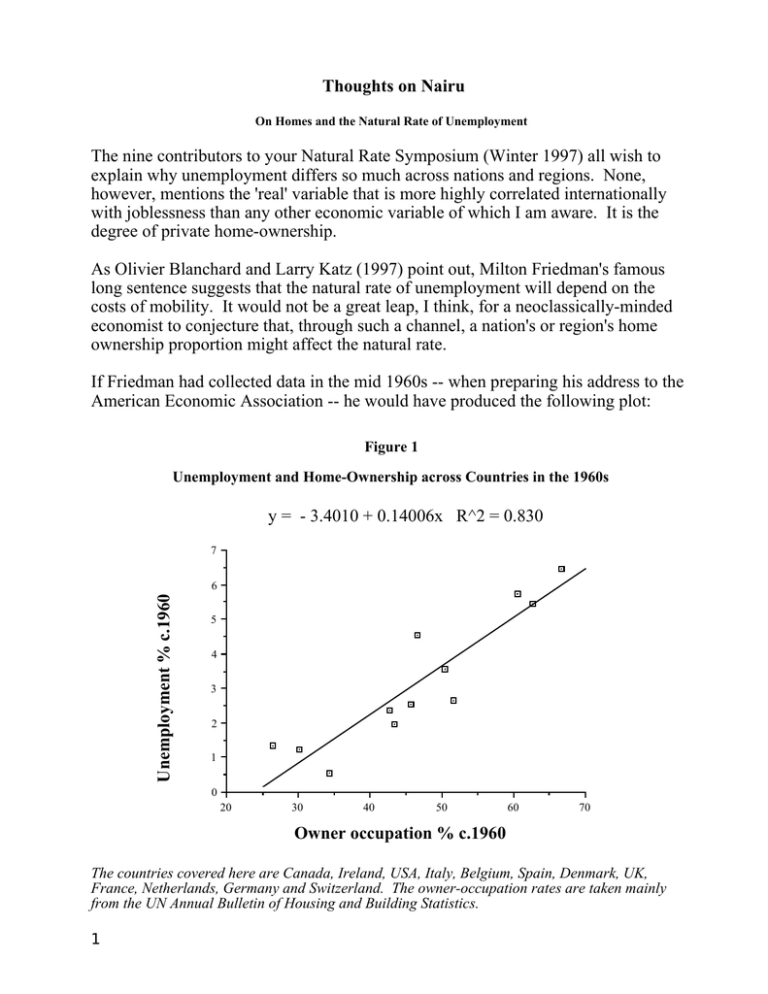Thoughts on Nairu
advertisement

Thoughts on Nairu On Homes and the Natural Rate of Unemployment The nine contributors to your Natural Rate Symposium (Winter 1997) all wish to explain why unemployment differs so much across nations and regions. None, however, mentions the 'real' variable that is more highly correlated internationally with joblessness than any other economic variable of which I am aware. It is the degree of private home-ownership. As Olivier Blanchard and Larry Katz (1997) point out, Milton Friedman's famous long sentence suggests that the natural rate of unemployment will depend on the costs of mobility. It would not be a great leap, I think, for a neoclassically-minded economist to conjecture that, through such a channel, a nation's or region's home ownership proportion might affect the natural rate. If Friedman had collected data in the mid 1960s -- when preparing his address to the American Economic Association -- he would have produced the following plot: Figure 1 Unemployment and Home-Ownership across Countries in the 1960s y = - 3.4010 + 0.14006x R^2 = 0.830 7 Unemployment % c.1960 6 5 4 3 2 1 0 20 30 40 50 60 70 Owner occupation % c.1960 The countries covered here are Canada, Ireland, USA, Italy, Belgium, Spain, Denmark, UK, France, Netherlands, Germany and Switzerland. The owner-occupation rates are taken mainly from the UN Annual Bulletin of Housing and Building Statistics. 1 If he had done this, and been sufficiently prescient, Friedman would probably have been concerned to know that over the next two decades most Western governments would offer large fiscal subsidies to home owners. With such prescience, he might not have been so surprised to reach the 1990s to discover that there were three European countries with unemployment rates close to 20% and these three had the highest home ownership rates (Ireland, Spain and Finland), nor to find that one country (Switzerland) had easily the lowest unemployment rate and the lowest homeownership rate. Of course it would be vital to check that the cross-country correlation itself withstands differencing for country fixed effects (Oswald 1996). The US was in the 1960s the part of the industrialized world with the greatest proportion of home owners. It then had the highest amount of unemployment -something many economists have forgotten. Since that time, the US has had almost no increase in unemployment and there has been almost no increase in its home ownership. In case all this might be thought of little interest to Americans in 1997, it is perhaps worth appending the following cross-state picture. The t statistic on the slope is slightly greater than two. Figure 2 The Correlation Between Changes in Unemployment and Owner-Occupation: The US States 1970-1990s y = 0.57849 + 0.12501x R^2 = 0.073 Change in state unem 70-90 6 4 2 0 -2 -4 -6 -10 0 10 Change in state own occ 70-90 2 20 The axes are 20-year changes, that is, they take the 1990 value minus the 1970 value. The data are for the 51 states of the US. The coefficient on the owner occupation variable is statistically significantly different from zero at the 5% level. Notes The source of the data is the Statistical Abstract of the US, 1993, Labor Statistics. It would be unwise, I think, to consider this idea more than a conjecture. Moreover, it would be at best part of a solution. Andrew J Oswald University of Warwick CV4 7AL England References Blanchard, Olivier, and Lawrence Katz, "What We Know and Do Not Know about the Natural Rate of Unemployment ," Journal of Economic Perspectives, Winter 1997, 51-72. Oswald, Andrew J., "A Conjecture on the Explanation for High Unemployment in the Industrialized Nations: Part I", University of Warwick Working Paper #475, December 1996. 3





